2007 CHEVROLET MALIBU stop start
[x] Cancel search: stop startPage 10 of 510
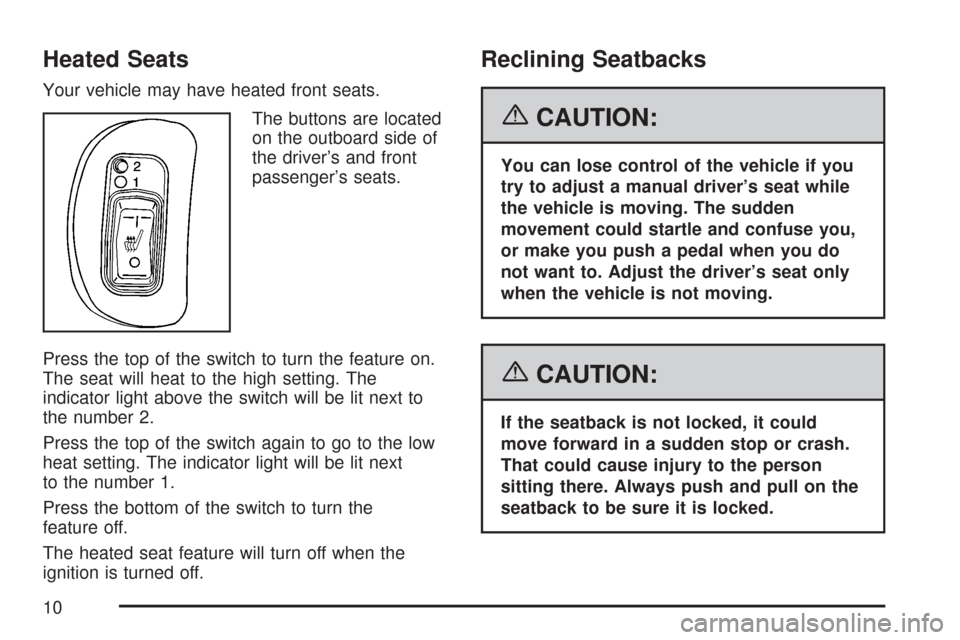
Heated Seats
Your vehicle may have heated front seats.
The buttons are located
on the outboard side of
the driver’s and front
passenger’s seats.
Press the top of the switch to turn the feature on.
The seat will heat to the high setting. The
indicator light above the switch will be lit next to
the number 2.
Press the top of the switch again to go to the low
heat setting. The indicator light will be lit next
to the number 1.
Press the bottom of the switch to turn the
feature off.
The heated seat feature will turn off when the
ignition is turned off.
Reclining Seatbacks
{CAUTION:
You can lose control of the vehicle if you
try to adjust a manual driver’s seat while
the vehicle is moving. The sudden
movement could startle and confuse you,
or make you push a pedal when you do
not want to. Adjust the driver’s seat only
when the vehicle is not moving.
{CAUTION:
If the seatback is not locked, it could
move forward in a sudden stop or crash.
That could cause injury to the person
sitting there. Always push and pull on the
seatback to be sure it is locked.
10
Page 115 of 510
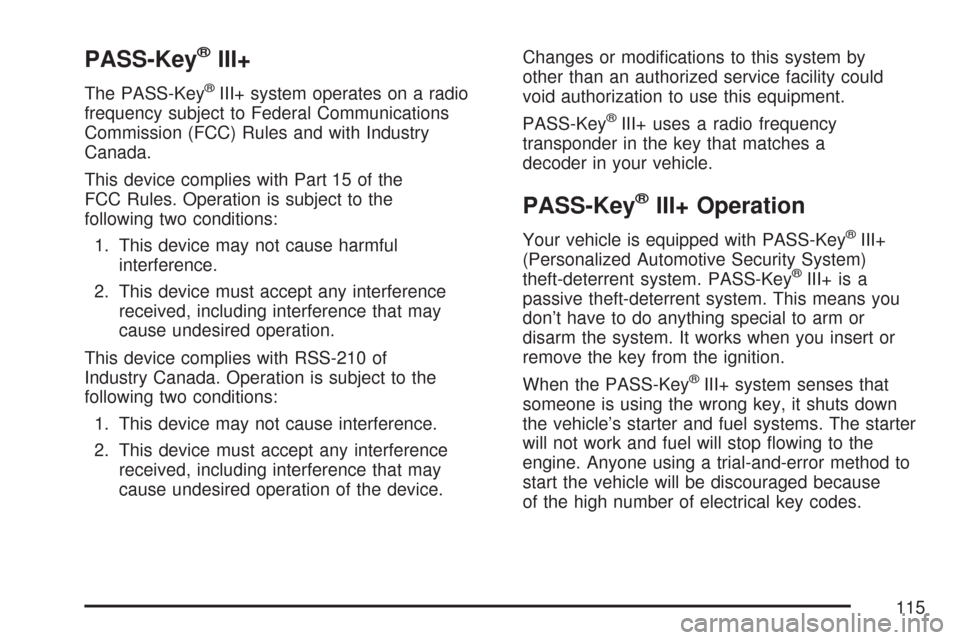
PASS-Key®III+
The PASS-Key®III+ system operates on a radio
frequency subject to Federal Communications
Commission (FCC) Rules and with Industry
Canada.
This device complies with Part 15 of the
FCC Rules. Operation is subject to the
following two conditions:
1. This device may not cause harmful
interference.
2. This device must accept any interference
received, including interference that may
cause undesired operation.
This device complies with RSS-210 of
Industry Canada. Operation is subject to the
following two conditions:
1. This device may not cause interference.
2. This device must accept any interference
received, including interference that may
cause undesired operation of the device.Changes or modi�cations to this system by
other than an authorized service facility could
void authorization to use this equipment.
PASS-Key
®III+ uses a radio frequency
transponder in the key that matches a
decoder in your vehicle.
PASS-Key®III+ Operation
Your vehicle is equipped with PASS-Key®III+
(Personalized Automotive Security System)
theft-deterrent system. PASS-Key
®III+ is a
passive theft-deterrent system. This means you
don’t have to do anything special to arm or
disarm the system. It works when you insert or
remove the key from the ignition.
When the PASS-Key
®III+ system senses that
someone is using the wrong key, it shuts down
the vehicle’s starter and fuel systems. The starter
will not work and fuel will stop �owing to the
engine. Anyone using a trial-and-error method to
start the vehicle will be discouraged because
of the high number of electrical key codes.
115
Page 117 of 510
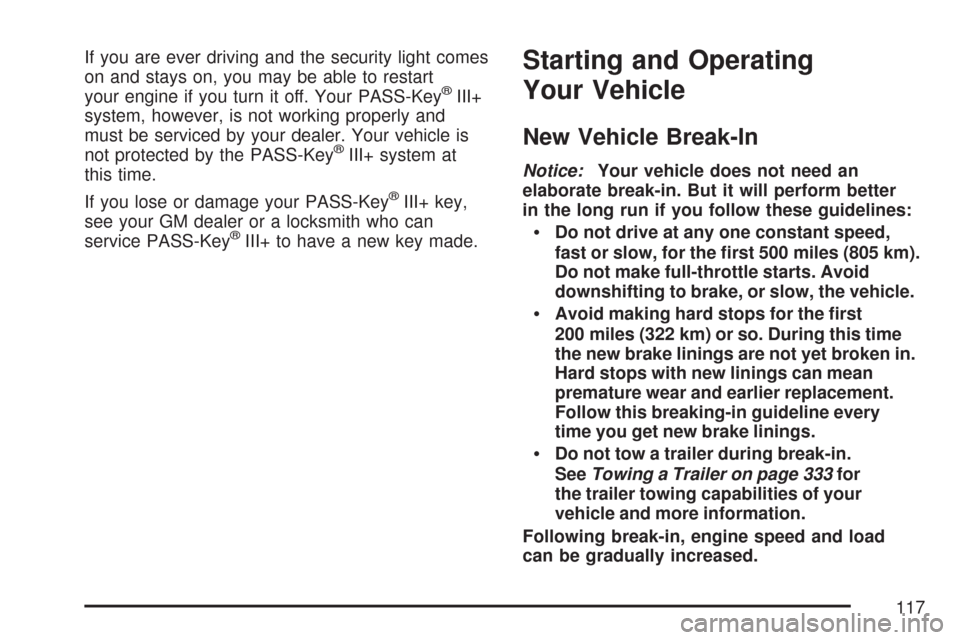
If you are ever driving and the security light comes
on and stays on, you may be able to restart
your engine if you turn it off. Your PASS-Key
®III+
system, however, is not working properly and
must be serviced by your dealer. Your vehicle is
not protected by the PASS-Key
®III+ system at
this time.
If you lose or damage your PASS-Key
®III+ key,
see your GM dealer or a locksmith who can
service PASS-Key
®III+ to have a new key made.
Starting and Operating
Your Vehicle
New Vehicle Break-In
Notice:Your vehicle does not need an
elaborate break-in. But it will perform better
in the long run if you follow these guidelines:
Do not drive at any one constant speed,
fast or slow, for the �rst 500 miles (805 km).
Do not make full-throttle starts. Avoid
downshifting to brake, or slow, the vehicle.
Avoid making hard stops for the �rst
200 miles (322 km) or so. During this time
the new brake linings are not yet broken in.
Hard stops with new linings can mean
premature wear and earlier replacement.
Follow this breaking-in guideline every
time you get new brake linings.
Do not tow a trailer during break-in.
SeeTowing a Trailer on page 333for
the trailer towing capabilities of your
vehicle and more information.
Following break-in, engine speed and load
can be gradually increased.
117
Page 120 of 510
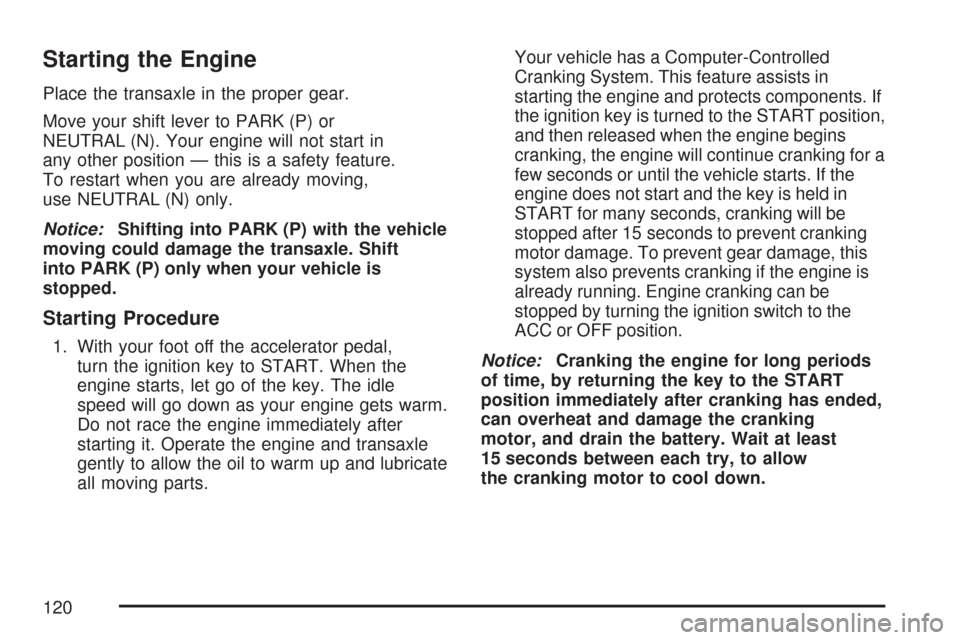
Starting the Engine
Place the transaxle in the proper gear.
Move your shift lever to PARK (P) or
NEUTRAL (N). Your engine will not start in
any other position — this is a safety feature.
To restart when you are already moving,
use NEUTRAL (N) only.
Notice:Shifting into PARK (P) with the vehicle
moving could damage the transaxle. Shift
into PARK (P) only when your vehicle is
stopped.
Starting Procedure
1. With your foot off the accelerator pedal,
turn the ignition key to START. When the
engine starts, let go of the key. The idle
speed will go down as your engine gets warm.
Do not race the engine immediately after
starting it. Operate the engine and transaxle
gently to allow the oil to warm up and lubricate
all moving parts.Your vehicle has a Computer-Controlled
Cranking System. This feature assists in
starting the engine and protects components. If
the ignition key is turned to the START position,
and then released when the engine begins
cranking, the engine will continue cranking for a
few seconds or until the vehicle starts. If the
engine does not start and the key is held in
START for many seconds, cranking will be
stopped after 15 seconds to prevent cranking
motor damage. To prevent gear damage, this
system also prevents cranking if the engine is
already running. Engine cranking can be
stopped by turning the ignition switch to the
ACC or OFF position.
Notice:Cranking the engine for long periods
of time, by returning the key to the START
position immediately after cranking has ended,
can overheat and damage the cranking
motor, and drain the battery. Wait at least
15 seconds between each try, to allow
the cranking motor to cool down.
120
Page 121 of 510

2. If the engine does not start after 5-10 seconds,
especially in very cold weather (below 0°F
or−18°C), it could be �ooded with too much
gasoline. Try pushing the accelerator pedal all
the way to the �oor and holding it there as you
hold the key in START for up to a maximum of
15 seconds. Wait at least 15 seconds between
each try, to allow the cranking motor to cool
down. When the engine starts, let go of the
key and accelerator. If the vehicle starts brie�y
but then stops again, do the same thing. This
clears the extra gasoline from the engine.
Do not race the engine immediately after
starting it. Operate the engine and transaxle
gently until the oil warms up and lubricates
all moving parts.
Notice:Your engine is designed to work with
the electronics in your vehicle. If you add
electrical parts or accessories, you could
change the way the engine operates. Before
adding electrical equipment, check with
your dealer/retailer. If you do not, your engine
might not perform properly. Any resulting
damage would not be covered by your
vehicle’s warranty.Adjustable Throttle and Brake Pedal
If your vehicle has this feature, you can change
the position of the throttle and brake pedals.
This feature is designed for shorter drivers, since
the pedals cannot move farther away from the
standard position, but can move rearward
for better pedal reach.
The ignition must be off or the vehicle in PARK (P)
for this feature to work. The feature will not work
if your foot is pushing on the throttle or brake
pedal. Remove your foot from the pedals
and press the switch again.
The switch used to
adjust the pedals
is located on the
left side of the
instrument panel.
121
Page 125 of 510
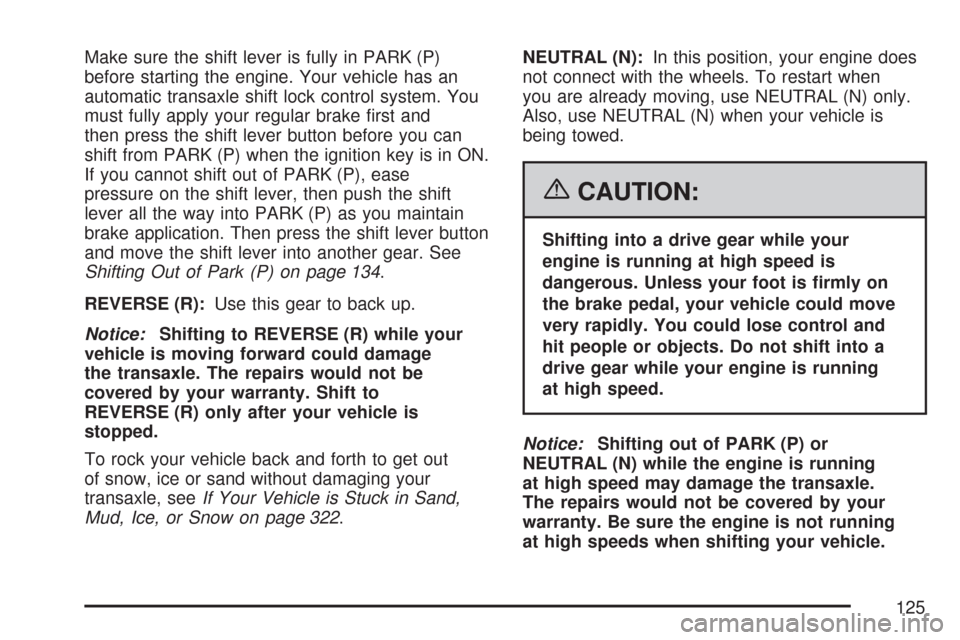
Make sure the shift lever is fully in PARK (P)
before starting the engine. Your vehicle has an
automatic transaxle shift lock control system. You
must fully apply your regular brake �rst and
then press the shift lever button before you can
shift from PARK (P) when the ignition key is in ON.
If you cannot shift out of PARK (P), ease
pressure on the shift lever, then push the shift
lever all the way into PARK (P) as you maintain
brake application. Then press the shift lever button
and move the shift lever into another gear. See
Shifting Out of Park (P) on page 134.
REVERSE (R):Use this gear to back up.
Notice:Shifting to REVERSE (R) while your
vehicle is moving forward could damage
the transaxle. The repairs would not be
covered by your warranty. Shift to
REVERSE (R) only after your vehicle is
stopped.
To rock your vehicle back and forth to get out
of snow, ice or sand without damaging your
transaxle, seeIf Your Vehicle is Stuck in Sand,
Mud, Ice, or Snow on page 322.NEUTRAL (N):In this position, your engine does
not connect with the wheels. To restart when
you are already moving, use NEUTRAL (N) only.
Also, use NEUTRAL (N) when your vehicle is
being towed.
{CAUTION:
Shifting into a drive gear while your
engine is running at high speed is
dangerous. Unless your foot is �rmly on
the brake pedal, your vehicle could move
very rapidly. You could lose control and
hit people or objects. Do not shift into a
drive gear while your engine is running
at high speed.
Notice:Shifting out of PARK (P) or
NEUTRAL (N) while the engine is running
at high speed may damage the transaxle.
The repairs would not be covered by your
warranty. Be sure the engine is not running
at high speeds when shifting your vehicle.
125
Page 129 of 510
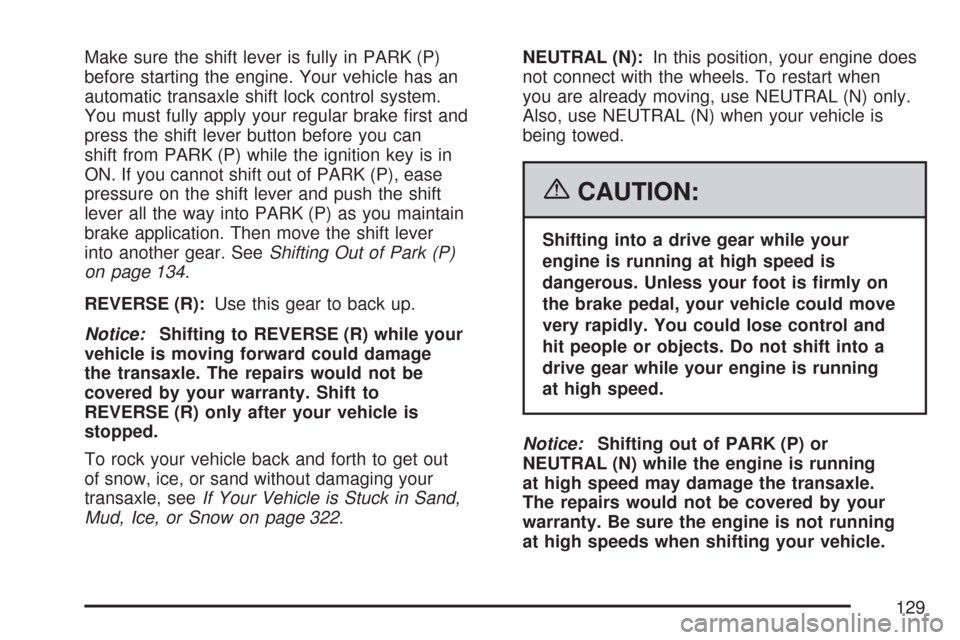
Make sure the shift lever is fully in PARK (P)
before starting the engine. Your vehicle has an
automatic transaxle shift lock control system.
You must fully apply your regular brake �rst and
press the shift lever button before you can
shift from PARK (P) while the ignition key is in
ON. If you cannot shift out of PARK (P), ease
pressure on the shift lever and push the shift
lever all the way into PARK (P) as you maintain
brake application. Then move the shift lever
into another gear. SeeShifting Out of Park (P)
on page 134.
REVERSE (R):Use this gear to back up.
Notice:Shifting to REVERSE (R) while your
vehicle is moving forward could damage
the transaxle. The repairs would not be
covered by your warranty. Shift to
REVERSE (R) only after your vehicle is
stopped.
To rock your vehicle back and forth to get out
of snow, ice, or sand without damaging your
transaxle, seeIf Your Vehicle is Stuck in Sand,
Mud, Ice, or Snow on page 322.NEUTRAL (N):In this position, your engine does
not connect with the wheels. To restart when
you are already moving, use NEUTRAL (N) only.
Also, use NEUTRAL (N) when your vehicle is
being towed.
{CAUTION:
Shifting into a drive gear while your
engine is running at high speed is
dangerous. Unless your foot is �rmly on
the brake pedal, your vehicle could move
very rapidly. You could lose control and
hit people or objects. Do not shift into a
drive gear while your engine is running
at high speed.
Notice:Shifting out of PARK (P) or
NEUTRAL (N) while the engine is running
at high speed may damage the transaxle.
The repairs would not be covered by your
warranty. Be sure the engine is not running
at high speeds when shifting your vehicle.
129
Page 131 of 510
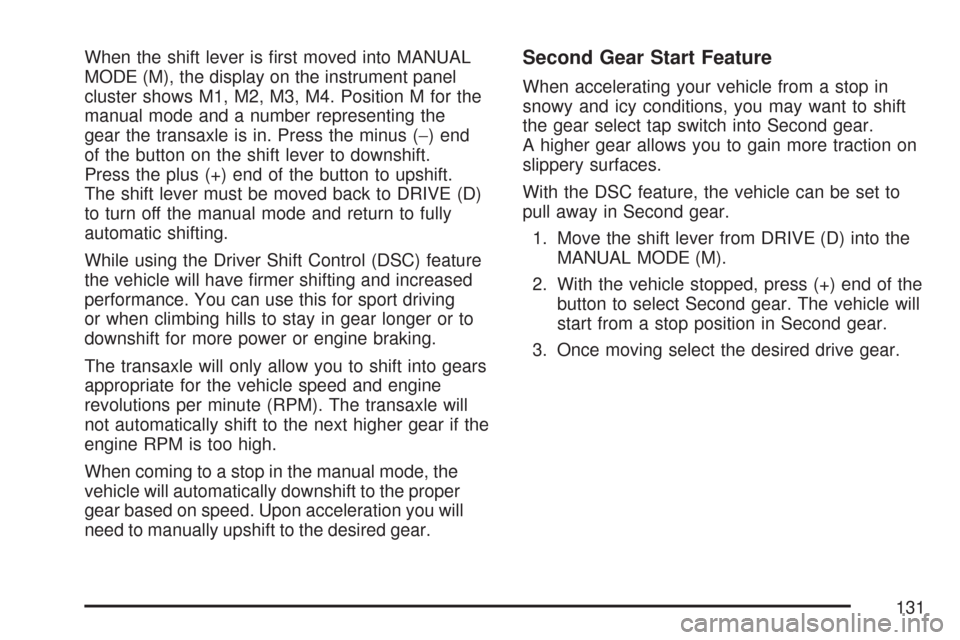
When the shift lever is �rst moved into MANUAL
MODE (M), the display on the instrument panel
cluster shows M1, M2, M3, M4. Position M for the
manual mode and a number representing the
gear the transaxle is in. Press the minus (−) end
of the button on the shift lever to downshift.
Press the plus (+) end of the button to upshift.
The shift lever must be moved back to DRIVE (D)
to turn off the manual mode and return to fully
automatic shifting.
While using the Driver Shift Control (DSC) feature
the vehicle will have �rmer shifting and increased
performance. You can use this for sport driving
or when climbing hills to stay in gear longer or to
downshift for more power or engine braking.
The transaxle will only allow you to shift into gears
appropriate for the vehicle speed and engine
revolutions per minute (RPM). The transaxle will
not automatically shift to the next higher gear if the
engine RPM is too high.
When coming to a stop in the manual mode, the
vehicle will automatically downshift to the proper
gear based on speed. Upon acceleration you will
need to manually upshift to the desired gear.Second Gear Start Feature
When accelerating your vehicle from a stop in
snowy and icy conditions, you may want to shift
the gear select tap switch into Second gear.
A higher gear allows you to gain more traction on
slippery surfaces.
With the DSC feature, the vehicle can be set to
pull away in Second gear.
1. Move the shift lever from DRIVE (D) into the
MANUAL MODE (M).
2. With the vehicle stopped, press (+) end of the
button to select Second gear. The vehicle will
start from a stop position in Second gear.
3. Once moving select the desired drive gear.
131